-
Paramedics' risk of being assaulted far exceeds risk to firefighting colleagues
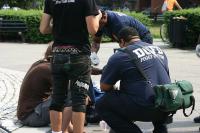
Research found that y medical technicians and paramedics are fourteen times more likely to be violently injured on the job than the firefighters they work alongside. The researchers found that assault-related injuries are often not reported, not acknowledged by administration, and therefore they are internalized by the workers as a “part of the job.”
-
-
Northwestern enhancing local safety with new volunteer emergency response training
Northwestern University says it is enhancing its commitment to the safety of its students, faculty, staff, and visitors by launching a new training session of its Community Emergency Response Team (CERT) program for volunteers this April. The CERT program is a volunteer opportunity and training program for community members to help support preparedness activities, community welfare during major special events and organized community recovery efforts following a crisis.
-
-
Mining social media improves disaster response efforts
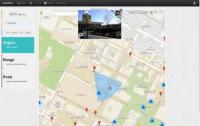
Leveraging publicly available social media posts could help disaster response agencies quickly identify impacted areas in need of assistance, according to a team of researchers. By analyzing the September 2013 Colorado floods, researchers showed that a combination of remote sensing, Twitter and Flickr data could be used to identify flooded areas.
-
-
A firefighter drone flies, crawls up walls
The 1974 American disaster film “Towering Inferno” depicted well the earnest struggles of firefighters engaged in ending a fire at a 138-story skyscraper. To this day, fires at high-rise buildings are considered one of the most dangerous disasters. Researchers developed a wall-climbing scout drone to fight fires in high-rises, finding the source of the fires and locating people trapped inside.
-
-
Precisely pinpointing first responder locations
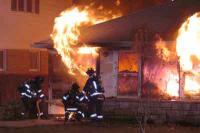
When firefighters rush into a burning building, it is essential that they and their operations team know their precise locations at all times. Even with global positioning systems (GPS) and other tracking technologies, environmental conditions, obstructions and interference from the building materials can severely limit pinpointing them. In the event of an injury, search teams rely on communications systems to rescue these first responders. DHS S&T is developing a new system to help tackle this challenge.
-
-
Remote-controlled robot inspects suitcase bombs
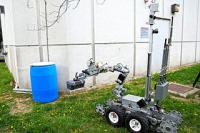
Abandoned items of luggage are frequently found at airports and train stations. This is a case for the emergency services, which have to assume that these items might contain bombs. They must assess the potential threat quickly, avert any possible danger, and preserve evidence for criminal proceedings. In the future, police will have the support of a remote-controlled sensor system as they go about their duties. Researchers are developing this sensor suite in cooperation with industry partners and criminal investigation authorities.
-
-
Snake robot range-sensing control system improves search-and-rescue performance

Rescue operations at disaster scenes often use robots to avoid further human danger. Modelling robots on snakes can provide better access through narrow paths in rubble, but previous models which control snake robots by the head do not adequately avoid collisions between the body of the robot and surrounding obstacles. Researchers say that to be more effective in search and rescue missions, robotic snakes should comprise a series of sections joined by links which either pitch up and down or yaw through sideways turning angles.
-
-
Locust-inspired robot traverses rocky terrain, assists in search and rescue

Since the 1980s, advanced robotic platforms have provided assistance to crisis intervention teams in the wake of man-made and natural disasters. The objective of such robots, in various sizes and shapes, has been to intervene where humans cannot and send life-saving data to rescue teams in the field. A new, locust-inspired robot, can jump eleven feet high — more than twice the height of similar-sized robots — and cover a horizontal distance of 4.5 feet in one leap. The researchers believe the robot will perform well in search-and-rescue missions and in reconnaissance operations in rough terrain.
-
-
U.S., Israel to co-develop technologies for first responders

Some $12 million will be funneled to collaborative Israeli-American projects for the development of advanced technologies for first responders over the next three years. The agreement brings together the Israeli Ministry of Public Security and the U.S. Department of Homeland Security in a drive to better equip and prepare both countries’ national rescue forces including fire, police, and first-aid units. Each side will invest equally in the project.
-
-
One third of U.K.'s specialized terrorist response vehicles to be scrapped
In 2004, to meet the threat of terrorists using chemical, biological, or nuclear weapons in an attack in the United Kingdom, the government introduced the Incident Response Units (IRUs), with their distinctive red coloring with yellow stripes, at a cost of £54 million. To save money, one third of all the fire brigade vehicles which were part of the IRUs, and which would have been called out in the event of terrorists setting off a “dirty bomb,” are being scrapped.
-
-
Improving active shooter response
When an active shooter strikes, every second counts. The sooner law enforcement can respond and the more information they have, the more lives can be saved. Battelle’s SiteGuard Active Shooter Response (ASR) provides a high tech, integrated approach to help protect building occupants in an active shooter event. The ASRcombines gunshot sensors with building security and communication systems to provide critical information to law enforcement and building occupants. As soon as the sensors detect a gunshot, SiteGuard ASR activates a series of predetermined actions and automated responses vital to occupant and first responder safety and optimized response.
-
-
FDA clears military traumatic wound dressing for use in civilian population
Early control of severe bleeding may prevent shock and may be life-saving., as 30 to 40 percent of civilian deaths by traumatic injury are the result of hemorrhaging. Of those deaths, 33 to 56 percent occur before the patient reaches a hospital. Last week the FDA cleared the use of the XSTAT 30 wound dressing, an expandable, multi-sponge dressing used to control severe, life-threatening bleeding from wounds in areas that a tourniquet cannot be placed (such as the groin or armpit) in battlefield and civilian trauma settings.
-
-
Human skin detection technology improves security, search and rescue
Color-image based systems are excellent at locating people in aerial search and rescue operations, but fall short when it comes to discerning between actual human skin and objects with similar hues. To remedy this, researchers have developed a novel two-dimensional feature space which uses the spectral absorption characteristics of melanin, hemoglobin and water to better characterize human skin.
-
-
Improving police responses to mass shootings
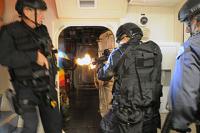
Before Columbine, law enforcement acted on the assumption that mass casualty incidents would involve a barricaded lone shooter who could be isolated, or a hostage situation in which the attackers would engage in negotiation before they killed more people. Thus, protocols established after the 1966 sniper attack at the University of Texas, called for first responders in the United States to set up a perimeter around the site of the shooting, gather as much information as possible, and then wait for specially trained assault teams, hostage negotiators, medics, and other specialists to arrive. “The assumption,” one expert said, “was that time was on their side.” Police forces arriving on the scene of a shooting no longer entertain this assumption.
-
-
DHS, NYPD train on response to active shooters

After months of coordination between the Department of Homeland Security (DHS) Science and Technology Directorate (S&T) and the New York Police Department (NYPD) Counter Terrorism Division, the NYPD conducted an active shooter training exercise on 22 November. S&T says that the exercise not only tested their training and proficiency, but also allowed them to incorporate several commercial technologies that could benefit future emergency situations.
-
More headlines
The long view
Using Drone Swarms to Fight Forest Fires
Forest fires are becoming increasingly catastrophic across the world, accelerated by climate change. Researchers are using multiple swarms of drones to tackle natural disasters like forest fires.
